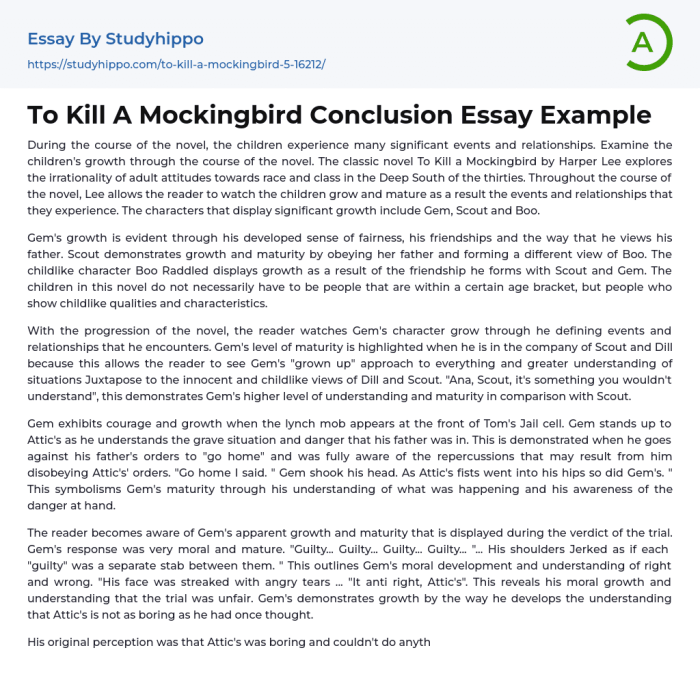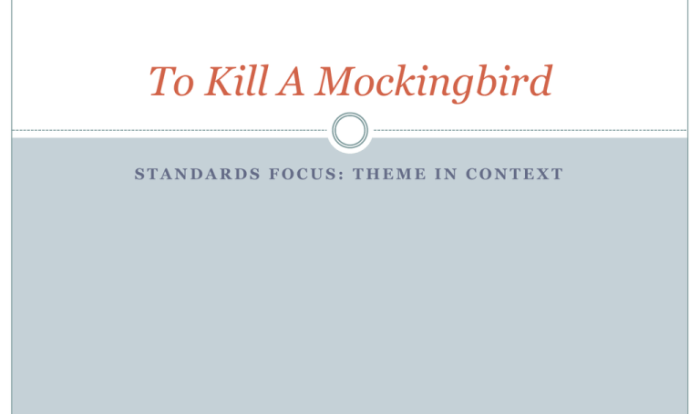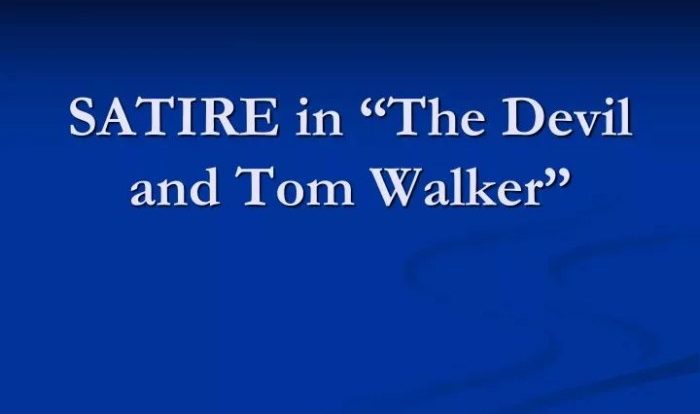To kill a mockingbird topics for essays – Dive into the captivating world of “To Kill a Mockingbird” with our comprehensive guide to essay topics. This literary masterpiece offers a wealth of thought-provoking themes and compelling characters, making it an ideal subject for insightful essays.
From the profound symbolism of the mockingbird to the complex dynamics of the Ewell family, this guide will provide you with the tools to explore the novel’s rich tapestry and craft compelling essays that delve into its timeless themes.
Symbolism and Motifs
In “To Kill a Mockingbird,” symbolism and motifs play a pivotal role in conveying the novel’s themes and messages. The mockingbird, for instance, symbolizes innocence, purity, and the destruction of innocence. Light and darkness serve as recurring motifs, representing the battle between good and evil within the characters and society as a whole.
Nature, too, is a significant motif, embodying the cyclical nature of life and the interconnectedness of all living things.
The Mockingbird
The mockingbird is a symbol of innocence and purity, as it is a harmless creature that only sings to bring joy to others. However, the novel also highlights the destruction of innocence, as the mockingbird is often targeted and killed for no reason.
This reflects the novel’s exploration of the loss of innocence and the destructive nature of prejudice.
Light and Darkness
Light and darkness are recurring motifs in the novel, representing the battle between good and evil. The light represents hope, justice, and compassion, while the darkness represents fear, ignorance, and prejudice. The novel’s characters are often torn between these two forces, and their choices ultimately determine their fate.
Nature
Nature is a significant motif in “To Kill a Mockingbird,” embodying the cyclical nature of life and the interconnectedness of all living things. The seasons change, plants grow and die, and animals live and die in a constant cycle. This reflects the novel’s exploration of the human condition and the inevitability of death.
Characters and Relationships

“To Kill a Mockingbird” features a complex cast of characters whose relationships and interactions drive the novel’s plot and themes. Atticus Finch, the protagonist, is a moral compass for the community, while Scout and Jem’s evolving relationship explores the complexities of growing up and learning about the world.
Atticus Finch
Atticus Finch is a highly respected lawyer and the father of Scout and Jem. He is known for his integrity, compassion, and unwavering belief in justice. Atticus serves as a moral compass for the community and teaches his children the importance of empathy and understanding.
Scout and Jem
Scout and Jem are Atticus’s children, and their evolving relationship is a central focus of the novel. Scout is a tomboyish and independent girl, while Jem is more mature and responsible. Their relationship is tested by the events of the novel, but they ultimately learn to support and rely on each other.
The Ewell Family
The Ewell family is a dysfunctional and impoverished family who represent the evils of society. Bob Ewell, the father, is a violent and racist man who is responsible for the novel’s climax. His children, Mayella and Burris, are also victims of their father’s abuse.
Social and Historical Context
“To Kill a Mockingbird” is set in the Jim Crow era, a time of racial segregation and inequality in the American South. The novel’s portrayal of racial prejudice and inequality is unflinching, and it highlights the devastating impact of racism on both individuals and communities.
Jim Crow Era
The Jim Crow era was a period of racial segregation and inequality in the United States that lasted from the late 19th century to the mid-20th century. During this time, African Americans were denied basic rights and freedoms, including the right to vote, the right to a fair trial, and the right to equal access to education and employment.
Racial Prejudice and Inequality
“To Kill a Mockingbird” vividly portrays the racial prejudice and inequality that existed during the Jim Crow era. The novel shows how racism affects not only African Americans, but also white people who challenge the status quo.
The Trial
The trial of Tom Robinson is a central event in “To Kill a Mockingbird.” The trial highlights the racism and injustice that are prevalent in the community, and it ultimately leads to Tom’s wrongful conviction and death.
Moral Dilemmas and Justice

“To Kill a Mockingbird” explores a number of moral dilemmas, including the conflict between justice and mercy, the role of compassion and empathy, and the flaws in the legal system. The novel’s characters are often forced to make difficult choices, and their decisions have far-reaching consequences.
Ethical Conflicts
The characters in “To Kill a Mockingbird” are often faced with ethical conflicts. For example, Atticus Finch must decide whether to defend Tom Robinson, even though he knows that Tom is likely to be convicted. Scout and Jem must decide whether to obey their father’s orders and stay away from the Ewells, even though they know that the Ewells are dangerous.
Compassion and Empathy
Compassion and empathy are important themes in “To Kill a Mockingbird.” The novel shows how compassion and empathy can help to overcome prejudice and hatred. For example, Atticus Finch teaches his children to see the world from other people’s perspectives, and Scout and Jem learn to understand and sympathize with the Ewells, even though the Ewells have treated them badly.
Flawed Legal System
“To Kill a Mockingbird” also highlights the flaws in the legal system. The novel shows how the legal system can be used to perpetuate injustice, and how the innocent can be punished while the guilty go free. For example, Tom Robinson is wrongfully convicted of raping Mayella Ewell, even though there is no evidence to support the accusation.
Literary Techniques and Style: To Kill A Mockingbird Topics For Essays

“To Kill a Mockingbird” is a masterfully written novel that employs a number of literary techniques and stylistic devices to convey its themes and messages. The novel’s unique narrative voice, use of foreshadowing and irony, and carefully crafted structure and pacing all contribute to its enduring appeal.
Narrative Voice
“To Kill a Mockingbird” is narrated by Scout Finch, a young girl who is looking back on her childhood. Scout’s narrative voice is unique and distinctive, and it helps to create a sense of intimacy and immediacy. Scout’s voice is also full of humor and wit, which helps to lighten the novel’s darker moments.
Foreshadowing and Irony, To kill a mockingbird topics for essays
Harper Lee uses foreshadowing and irony throughout “To Kill a Mockingbird” to create suspense and to highlight the novel’s themes. For example, the novel opens with a description of the Radley house, which is a symbol of mystery and fear.
This foreshadows the events that will unfold later in the novel, when Scout and Jem become involved with the Radleys.
Structure and Pacing
The structure and pacing of “To Kill a Mockingbird” are carefully crafted to create a sense of tension and suspense. The novel is divided into two parts, with the first part focusing on Scout and Jem’s childhood and the second part focusing on the trial of Tom Robinson.
The first part is relatively lighthearted and humorous, while the second part is more serious and suspenseful.
Adaptations and Interpretations
“To Kill a Mockingbird” has been adapted into a number of films, stage productions, and other works of art. Each adaptation brings its own unique interpretation to the novel, and they all offer valuable insights into the novel’s themes and characters.
Film Adaptations
“To Kill a Mockingbird” has been adapted into two feature films, one in 1962 and one in 1999. The 1962 film is widely considered to be one of the greatest films ever made, and it won three Academy Awards, including Best Actor for Gregory Peck’s portrayal of Atticus Finch.
Stage Productions
“To Kill a Mockingbird” has also been adapted into a number of stage productions. The first stage adaptation was produced in 1970, and it has since been performed all over the world. The stage adaptation is faithful to the novel, and it captures the novel’s themes and characters in a powerful and moving way.
Legacy and Impact
“To Kill a Mockingbird” has had a profound impact on American culture. The novel has been praised for its insights into racism, justice, and the human condition. It has also been credited with inspiring generations of readers to fight for justice and equality.
Top FAQs
What are the key symbols in “To Kill a Mockingbird”?
The mockingbird, light and darkness, and nature are central symbols that convey themes of innocence, prejudice, and the human condition.
How does the novel explore the theme of racial inequality?
Through the trial of Tom Robinson, the novel exposes the deep-seated racism and injustice prevalent in the Jim Crow era.
What is the significance of Atticus Finch as a character?
Atticus represents the moral compass of the novel, embodying integrity, empathy, and the pursuit of justice.


